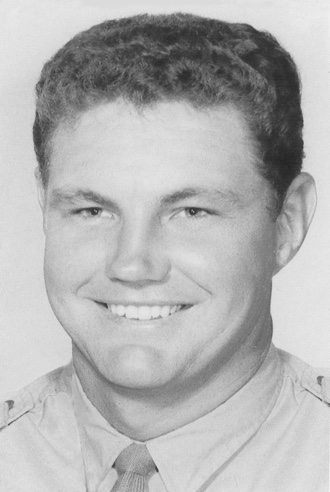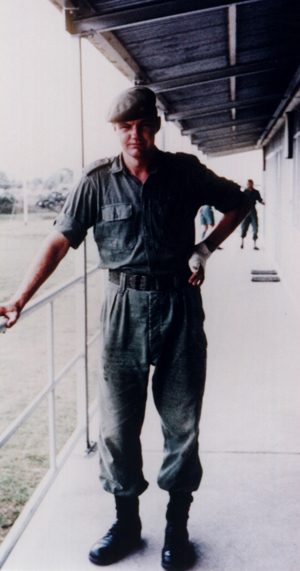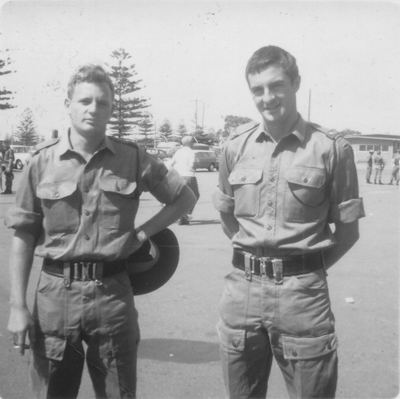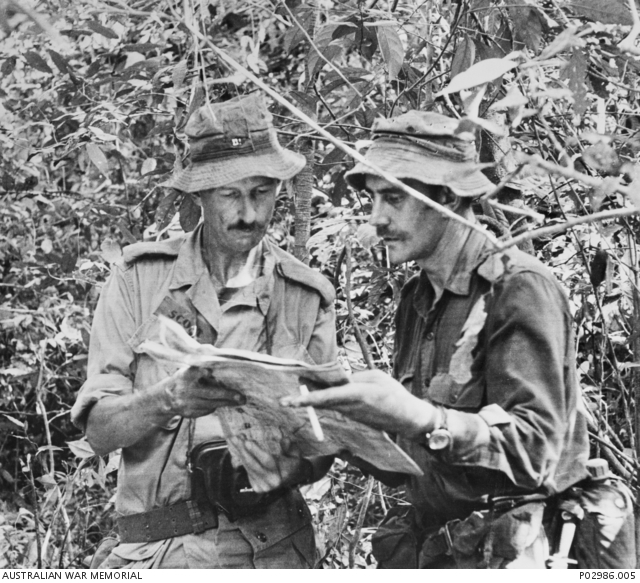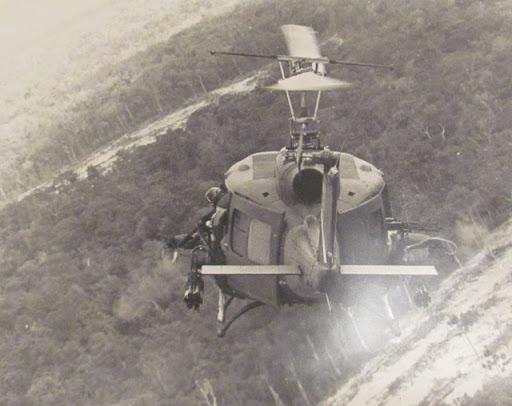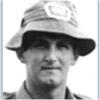|
3rd Battalion Royal Australian Regiment
Your FaithfullyJapan - Korea - Malaya - Borneo - Vietnam - East Timor - Solomons - Iraq - Afghanistan |
| 3rd Battalion Royal Australian Regiment |
|
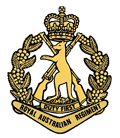 |
|
| Roll of Honour Redirections for this page: Last Post Ceremony David Paterson The Life of David Paterson Audio file Contact 20th March, 1971 Contact 20th March 1971 The Gentle Giant David Paterson My Memory of 2Lt David Paterson by Stacey Kruck |
|
2Lt David Paterson |
|
4718855 Second Lieutenant David Paterson, 3rd Battalion, the Royal Australian Regiment Today we remember and pay tribute to Second Lieutenant David Paterson. David Paterson was born on 4 January 1945 in Port Adelaide, South Australia, the second of two sons born to Ernst and Dorothy Paterson. Paterson attended Port Adelaide Primary School and later Woodville High School. He enjoyed swimming, played basketball at the St Claire Recreational Centre, and was a member of the Ethelton Swim Club, where, in 1966, he met Christine Weber, his future wife. When Paterson graduated from high school he began teacher training at Western Teachers’ College, receiving his diploma days before his 20th birthday. On 11 January 1965 he was accepted as the sole teacher at Mount Hill Rural School on the Eyre Peninsula. His students, of which there were 20, came to admire him for his unstinting efforts to guide and challenge them to achieve their best. He settled quickly into the local community, assisted in organising local swimming carnivals and played Australian Rules football for Wharminda Football Club. He also played basketball in Cleve for the teachers’ team. With an imposing height of 6 feet, 6 inches, he could not be missed on field or court. During his two years at Mount Hill he continued his studies and was twice given a deferral from his National Service obligation. Paterson began his National Service training in 1967. During initial training at Puckapunyal he was selected to attend an officers’ course. He became a member of Class 1/67 at the Officer Training Unit, Scheyville. One of his fellow graduates later recalled, “during intensive training [Paterson] proved to be an outstanding leader and a highly competent commander, and his boys loved and respected him immensely.” After successfully completing the course, Paterson was commissioned as second lieutenant on 14 July 1967 and posted as platoon commander to the Pacific Islands Regiment in Papua New Guinea. Here he played a vital role in educating local soldiers, particularly in the areas of civic and civil responsibilities. Paterson completed his National Service commitment in January 1969 and despite his desire to return to teaching, he extended his commission, expressing a desire to serve in South Vietnam. He was posted as an instructor to the Jungle Training Centre at Canungra in Queensland where he spent the next year training men for service in South Vietnam. On 4 October 1969, during a period of leave, Paterson married his long-time sweetheart Christine at Mount Carmel Catholic Church near Port Adelaide. At the beginning of January 1970 Paterson was posted to the 3rd Battalion, the Royal Australian Regiment (3RAR) based at Woodside in South Australia. He was sent to C Company and was made officer commanding 8 Platoon. At this time 3RAR was being brought up to strength and undergoing extensive training in preparation for deployment to South Vietnam. In September, Paterson and Christine welcomed their daughter Sarah into the world. But time at home was limited as 3RAR continued to train for its deployment. Paterson was part of 3RAR’s advance party that flew out of Australia on 11 February 1971 landing in Saigon the following day. The remainder of the battalion arrived later that month and began operations almost immediately after. Paterson collapsed with heat stroke during the first patrol and his boots began to fail him. The size of his feet meant that he had to have boots made especially for him. With no spares available, he was forced to use tape and rubber bands to keep them intact. On the morning of 20 March, after a five-day ambush operation, Paterson led his platoon back out on patrol. After an uneventful morning, a track with signs of recent of use was found, and a forward scout noticed an enemy lookout sitting on a rock. The lookout also spotted the Australians and ran into the bush. Paterson decided to split the platoon. He led half of the platoon towards the noise while the other half, led by his platoon sergeant, approached from a different direction. Paterson’s group dropped packs and advanced cautiously. As the men moved forward, they came under fire from automatic rifles, machine-guns and rocket propelled grenades. The remaining members of the platoon engaged the enemy for several hours. Air support was supplied by gunships of No. 9 Squadron, RAAF, but locating positions on the ground was almost impossible. The diggers had used their only smoke grenade early in the contact and in an attempt to drop more smoke grenades to them, one of the gunships, was badly damaged. It was not until close to 6pm when the wounded from 8 Platoon were evacuated. Paterson’s body was flown out separately. His men described him as an “exceptional human being… fair, sensible and enormously popular.” His remains were returned to Australia. After a funeral service conducted by Chaplain Gavan Kennare, he was laid to rest with full military honours in Centennial Park Cemetery, Adelaide. He was 26 years old. Paterson’s name is listed on the Roll of Honour on my left, along with more than 500 others from the Vietnam War, and his photograph is displayed today beside the Pool of Reflection. This is but one of the many stories of courage and sacrifice told here at the Australian War Memorial. We now remember Second Lieutenant David Paterson, who gave his life for us, for our freedoms, and in the hope of a better world. Michael Kelly |
|
 |
|
| The Life of David Paterson David Paterson was born in Port Adelaide on the 4th of January 1945 to Mr Ernest Mathew and Mrs Dorothy Paterson. He had an older brother, Peter. David attended Port Adelaide Primary school and then Woodville High School.  He enjoyed swimming, being a member of the Ethelton Swim Club; and basketball, playing at the St. Claire recreational centre. After graduating from school, David immediately began teacher training at the Western Teachers’ College. A few days before his 20th birthday, he graduated from college and was accepted into a one-teacher school in Mount Hill on the 11th January 1965. Whilst there he continued swimming and basketball and also took up football for his local football club. The posting at Mount Hill lasted for two years. During this time he began travelling to Cleve and continued studying. It was because of this study that he had his National Service postponed twice. He loved his teaching and the students adored him.  David on excursion with students from Mount Hill A fellow veteran after returning from Vietnam went back to Mount Hill to interview David’s students and found, “David is remembered with great fondness who enriched and valued their communities…It was very clear to me that David had left a lasting impression on these students”. In 1966, David met his future wife Christine at the Ethelton swimming club. 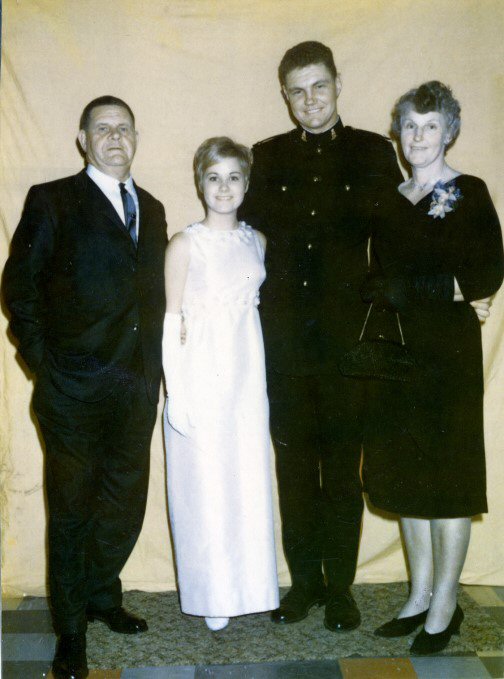 Photograph: Ernest Mathew Paterson, Christine Weber, David and Mrs. Dorothy Paterson In 1967 David was conscripted to National Service with the Australian Army and selected for Officer Training and posted to Scheyville Officer Training College. The 5 month Officer training is demanding and a gruelling experience for national servicemen who showed particular positive aptitudes and academic potential.. 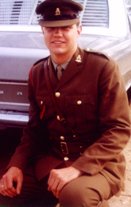 A fellow platoon commander stated, “During intensive training, [David] proved to be an outstanding leader and a highly competent commander, and his boys loved and respected him immensely.” It took 12 months to finish officer training, but after completion he was posted to the Pacific Islands Regiment. This post took David to Papua New Guinea where he played a crucial role in educating local soldiers. In February 1969, at the completion of his National Service commitment David decided to enlist into the Australian Army full time and was posted to the 3rd Battalion Royal Australian Regiment which was located in Woodside, South Australia. On the 4th October 1969 David married Christine Weber, his long-time sweetheart. It was while he resided in Woodside that his daughter Sarah was born on 12th September 1970. 2Lt David Paterson was the commanding officer of 8 Platoon, Charlie Company when the 3rd Battalion RAR was posted to South Vietnam arriving there about 2nd February with the advanced party. The remainder of the platoon along with second in command, Sgt. Claude Hoppe travelled the 10 days aboard the Naval aircraft carrier HMAS Sydney (HMAS Sydney was aircraft carrier converted to carry cargo and troop to and from the Vietnam War campaign.)  2Lt David Paterson was respected as one of the best mappers in the Battalion with an ability to pinpoint locations as being crucial when destroying the enemy positions and keeping artillery away from our allies. In the thick jungles of Vietnam, this skill was vital. David, or as he became known in the military as “Dave” or “Paddo” was also known for his massive stature, standing over six foot, seven inches tall. He had ginormous feet which had grown to shoe size 18! His mates made the joke that with him nothing would happen if he was shot because his whopping feet would keep him standing. The 3rd Battalion en-mass proceeded on its first in country combat Operation on the 5th February 1971 with all companies proceeding through the protective wire of the Australian Task Force Base of Nui Dat. The operation would assist in practising orientation, allow the troops to develop routines and to assist in acclimatising to the tropic heat and humidity. It was during this period that 2Lt David Paterson suffered heat stroke.
Initially he could not take in any water and it took him several days to recover but he stayed in the field and opted for conducting a prolonged ambush in static positions until fully recovered. On the morning of the 20th March 8 platoon Charlie company patrolled a section of well defined road before observing an overgrown Ox cart track that ordinarily would not have activity upon it. 2Lt David Paterson elected to follow up and patrol the well defined but overgrown track A short time later forward scout of the lead section Pte Alan Gould observed one individual sitting on a rock next to the track. The individual having spotted Alan took off into the bush surrounding the track. David Paterson decided to follow up on this individual which resulted in a contact a short time later. 2Lt David Paterson and Pte Alan Gould lay where they fell with the rest of the half section platoon falling back to consolidate a position to regain advantage. |
|
| Redirections for this page: The Life of David Paterson Audio file Contact 20th March, 1971 Contact 20th March 1971 The Gentle Giant David Paterson My Memory of 2Lt David Paterson by Stacey Kruck |
|
2Lt David Paterson Tail end Charlie often spends most of his time walking backwards watching the rear for enemy following or to stop the platoon from being attacked from the rear, or the sides. I was doing just that when suddenly I backed into the soldier in front but behind me and whilst falling to the ground, I noticed that "enemy" signal was being given by nearly every soldier along the line. Enemy had been sighted sitting on a rock that lay beside the track some distance away. The platoon scout and enemy soldier spied each other at the same time. The scout propped where he was and went to ground sending enemy signal back. The sighted enemy escaped west into scrub. |
|
| The Gentle Giant David Paterson (1/67) The following extract from the book FLASHBACK by Peter Haran & Robert Kearney, appears courtesy of New Holland Publishers, who with the authors kindly gave permission for this extract to be published in The Scheyviltian. John Neervoort (1/67-2/67) was a friend of David at OTU in 1967, has met both of the authors and arranged for this extract. Lieutenant David Paterson hoisted his backpack up onto his enormous frame and prepared to lead his men out on patrol. The National Serviceman was commander of 8 Platoon, C Company, 3RAR. Your first impression of him was his size - he topped six feet, six inches, and his boots were especially handmade to fit his size-15 feet. He was a gentle giant, a family man who spoke lovingly of a wife and baby daughter and regularly attended church services. His platoon sergeant was Claude Hoppe. The platoon had been on operations since February 27, 1971; it was now March 18. The previous weeks had been spent patrolling and ambushing - heavy and frustrating work, but with no contact. Paterson and Hoppe wondered when they would see real action. Patrolling north-west of Xuyen Moc on March 18, Paterson and his platoon stumbled upon a large enemy bunker complex. Paterson had found an empty one, but the recently abandoned cooking fires indicated it hadn't been long vacated. 'About time we found something - and time we had some action,' one of 8 Platoon's soldiers said to Hoppe. The sergeant knew in his guts his platoon was going to get action soon enough - the ingredients had been shaping up for days; tracks with fresh boot marks, sporadic contact that other platoons had experienced in the Xuyen Moc area, and the number of bunker systems that had been found. 'It'll happen soon enough, mate,' he replied. Paterson called an O Group, and the decision was made to split the platoon into two groups to cover more ground. Hoppe would lead one group, Paterson the other. This doubled the number of grid squares that could be searched in one day. It was an acceptable practice at the time but also a potentially dangerous one. With the chance of hitting an enemy party no more than squad size - five or six - the Aussie half platoon method had merit. But Paterson remembered that at Canungra Jungle Training Centre he had been warned about decreasing the size of a fighting patrol to anything less than 15 men. The posted strength of a rifle platoon was one officer and 33 other ranks, including the platoon sergeant. Through attrition, transfers, sickness and lack of reinforcements, 8 Platoon was already down to 25 men. Splitting also meant that one of the groups had only one M60 machine- gun. There were three M60s to a platoon, and getting a fourth issued was almost impossible, as additional weapons were another casualty of the war since the wind-down had commenced. (1ATF now consisted of only 3RAR and 4RAR.) On the morning of March 20, Paterson and Hoppe took their half- platoon groups out looking for the enemy, D445, and more bunkers. It was a sweltering day and Paterson bush-bashed, pushing his men until lunchtime. Resuming after the break, they had moved less than 200 metres when they found a track showing signs of ox-cart use. Then, through the silence, came the unmistakable sound of men chopping wood. 'Jeez, they're bloody confident, Skip,' Martin Cross whispered. 'Buggers are rowdier than a wood-chopping competition.' Paterson ordered the mini-platoon to drop their packs and move into an extended line. Once they had shaken out, he waved them further into the gloom of the thick bush. Was it local woodcutters or the enemy? Paterson's scout, Alan 'Gouldy' Gould, moved to his commander's right while the machine-gun group moved to the left, the high ground. The VC were waiting less than 50 metres away in a U-shaped bunker system, and began to sight up automatic rifles, RPGs and a 12.7mm heavy machine-gun on the approaching diggers. They released the full arsenal in one deadly fusillade. Paterson realised moments before he was hit, that his half-platoon had stumbled into a bunker complex of Company size. Worse, the enemy was equipped with heavy weapons and they weren't bugging out as per normal practice, they were staying to fight. It was D445 Vietcong unit, reinforced with regular force members of the 3/33 NIVA Regiment. Scout Alan Gould saw an M79 grenade launcher go off, heard the distinctive dupe it makes, then felt the blast of an incoming RPG explode nearby. He was thrown to the ground and blood began to spurt from his chest. He could taste and feel warm fluid running down his throat: he heard a curious whistling sound coming from his chest. I've been hit in the lung.  Peterson started crawling over to him, and shouted above the roar of fire, 'You're gonna be okay!'. Gould's last impression was watching tracers overhead while he lay in the leaves. His section was pouring fire onto the enemy, who were still trying to close in and kill the wounded Australians. The enemy's 12.7 heavy machine-gun was cutting above Gould's head, felling small trees, and he could just see his section commander, Russ Petty, desperately trying to get him. Paterson and 8 Platoon were pinned down by a blizzard of enemy fire. Dave Paterson was mortally wounded: two other men, the machine-gunner and Gould, had been hit. Things were getting worse - all the soldiers were almost out of ammunition and smoke grenades, which were desperately needed to mark their position. The spare ammo and smoke grenades were in the packs back where they had been dropped. As their leader, Paterson knew he had to do something. Martin Cross was convinced the enemy would now advance from the bunker complex and overrun the Aussies' thin line of defence. Paterson turned, waved his arm and called, 'Back, get back to the packs ... go now, I'm covering,' He propped himself up and fired another burst from his Armalite. Cross got to his knees and worked his way backwards, crab-style, with the two men closest to him, John Melma and Ross Budden. As they reached a nearby clump of bamboo there was another sustained burst of enemy fire The members of 8 Platoon were fighting for their lives. The wall of fire had become sporadic and the platoon popped its last smoke grenade to assist an ammunition drop. The moment the coloured smoke began to filter upwards, another smoke grenade popped and sent the same colour upwards - inside the enemy perimeter. Martin Cross's heart sank. They've used the same coloured smoke. Cunning bastards, they were waiting for that. Lt. David Paterson, KIA, March 20, 1971. As you walk past the APC you have to look: you don't want to, but you have to. Patto, the gentle giant with boots so big they're handmade: Patto the Nasho, liked by all. Patto now lying on the seat of the carrier. He still has a few blades of grass in his hand, grass he must have clutched as he died. Maybe in a minute he'll get up and walk out and ask for a brew. Hell, why would they make such a huge man an Infantry commander? Men that big don 7 belong in the jungle, the jungle's for shorter people - people you don't see so easy. The dust off arrived to take the dead and wounded. The medic was adamant. 'The rule is, the wounded never travel with the dead. I don't give a toss how you do it, Sarge, but the wounded aren't travelling with their dead skipper.' Later that day a second dust off came in. Paterson was loaded on to the Iroquois with as much gentleness as they could muster. You couldn't help but notice the one huge boot that stuck out from the poncho liner wrapped around the body. There was a rubber band around it to stop the detached sole flapping. He would have walked many clicks with that rubber band, snagging on every vine he stepped over. The Army just didn't have spare boots that size to fly in on a resupply.  8 Platoon, Charlie Company, 3 RAR 1971 Woodside. South Australia (Missing Pte A J Cox & Pte R Barrie) |
|
| Redirections for this page: The Life of David Paterson Audio file Contact 20th March, 1971 Contact 20th March 1971 The Gentle Giant David Paterson My Memory of 2Lt David Paterson by Stacey Kruck |
|
My memory of 2nd Lieutenant David Patterson |
|
2Lt David Paterson But virtually unknown is David Paterson the only teacher (and SAIT member) killed in action in Vietnam. Only six years earlier, he had started his teaching career with the South Australian Education Department when, on 1 January 1965, he was appointed head teacher of Mount Hill Rural School, a small one man teacher school in the middle of Eyre Peninsula. Prior to that he had been a leaving teacher scholar at Woodville High School and completed a two year teacher training course at Western Teachers College. |
|
|
|
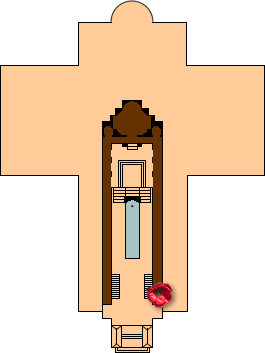 |
|
Australian War Memorial Location on the Roll of HonourDavid Paterson's name is located at panel 4 in the Commemorative Area at the Australian War Memorial (as indicated by the poppy on the plan). |
|
| Return to Roll of Honour | |
 |
| The 3 RAR Internet site gratefully acknowledges the assistance of 101 design of Wollongong. www.101design.com.au |
